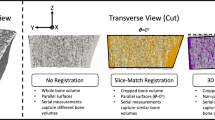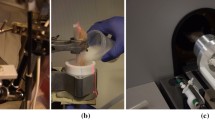Abstract
While bone mineral density has been traditionally used to quantify fracture risk for individuals with spinal cord injuries, recent studies are including engineering measurements such as section modulus and cross sectional moment of inertia. These are almost exclusively calculated by peripheral QCT scanners which, unlike DXA scanners, are rarely found in clinical settings. Using fifty-four fresh frozen femora, we developed and validated a pixel-by-pixel method to calculate engineering properties at the distal femur using a Hologic QDR-1000 W DXA scanner and compared them against similar parameters measured using a Stratec XCT-3000 peripheral QCT scanner. We found excellent agreement between standard DXA and pixel-by-pixel measured BMD (r 2 = 0.996). Cross-sectional moment of inertia about the anteroposterior axis measured using DXA and pQCT correlated very strongly (r 2 = 0.99). Cross-sectional moment of inertia about the anteroposterior axis measured using DXA also correlated strongly with pQCT measured bone strength index (r 2 = 0.99). These correlations indicate that DXA scans can measure equivalent pQCT parameters, and some existing DXA scans can be reprocessed with pixel-by-pixel techniques. Ultimately, these engineering parameters may help better quantify fracture-risk in fracture-prone populations such as those with spinal cord injuries.







Similar content being viewed by others
References
Ashe, M. C., J. J. Eng, A. V. Krassioukov, D. E. Warburton, C. Hung, and A. Tawashy. Response to functional electrical stimulation cycling in women with spinal cord injuries using dual-energy X-ray absorptiometry and peripheral quantitative computed tomography: a case series. J. Spinal Cord Med. 33:68–72, 2010.
Beck, T. J., A. C. Looker, C. B. Ruff, H. Sievanen, and H. W. Wahner. Structural trends in the aging femoral neck and proximal shaft: analysis of the third national health and nutrition examination survey dual-energy X-ray absorptiometry data. J. Bone Miner. Res. 15:2297–2304, 2000.
Beck, T. J., C. B. Ruff, K. E. Warden, W. W. Scott, and G. U. Rao. Predicting femoral neck strength from bone mineral data. A structural approach. Invest. Radiol. 25:6–18, 1990.
Blake, G. M., D. B. McKeeney, S. C. Chhaya, P. J. Ryan, and I. Fogelman. Dual energy x-ray absorptiometry: the effects of beam hardening on bone density measurements. Med. Phys. 19:459–465, 1992.
Bolotin, H. H. Inaccuracies inherent in dual-energy X-ray absorptiometry in vivo bone mineral densitometry may flaw osteopenic/osteoporotic interpretations and mislead assessment of antiresorptive therapy effectiveness. Bone 28:548–555, 2001.
Cleek, T. M., and R. T. Whalen. Cross-sectional structural parameters from densitometry. J. Biomech. 35:511–516, 2002.
Cleek, T. M., and R. T. Whalen. Effect of activity and age on long bones using a new densitometric technique. Med. Sci. Sports Exerc. 37:1806–1813, 2005.
Comarr, A. E., R. H. Hutchinson, and E. Bors. Extremity fractures of patients with spinal cord injuries. Am. J. Surg. 103:732–739, 1962.
Culafić, D., D. Djonic, V. Culafic-Vojinovic, S. Ignjatovic, I. Soldatovic, J. Vasic, T. J. Beck, and M. Djuric. Evidence of degraded BMD and geometry at the proximal femora in male patients with alcoholic liver cirrhosis. Osteoporos. Int. 26:253–259, 2015.
Danielson, M. E., T. J. Beck, A. S. Karlamangla, G. A. Greendale, E. J. Atkinson, Y. Lian, A. S. Khaled, T. M. Keaveny, D. Kopperdahl, K. Ruppert, S. Greenspan, M. Vuga, and J. A. Cauley. A comparison of DXA and CT based methods for estimating the strength of the femoral neck in post-menopausal women. Osteoporos. Int. 24:1379–1388, 2013.
Dudley-Javoroski, S., and R. K. Shields. Longitudinal changes in femur bone mineral density after spinal cord injury: effects of slice placement and peel method. Osteoporos. Int. 21:985–995, 2009.
Eser, P., A. Frotzler, Y. Zehnder, and J. Denoth. Fracture threshold in the femur and tibia of people with spinal cord injury as determined by peripheral quantitative computed tomography. Arch. Phys. Med. Rehabil. 86:498–504, 2005.
Ferretti, J. L., R. F. Capozza, and J. R. Zanchetta. Mechanical validation of a tomographic (pQCT) index for noninvasive estimation of rat femur bending strength. Bone 18:97–102, 1996.
Freehafer, A. A., C. M. Hazel, and C. L. Becker. Lower extremity fractures in patients with spinal cord injury. Spinal Cord 19:367–372, 1981.
Garland, D., and R. Adkins. Bone loss at the knee in spinal cord injury. Top. Spinal Cord Inj. Rehabil. 6:37–46, 2001.
Garland, D., R. Adkins, and C. Stewart. Fracture threshold and risk for osteoporosis and pathologic fractures in individuals with spinal cord injury. Top. Spinal Cord Inj. Rehabil. 11:61–69, 2005.
Garland, D. E., R. H. Adkins, C. A. Stewart, R. Ashford, and D. Vigil. Regional osteoporosis in women who have a complete spinal cord injury. J. Bone Jt. Surg. 83:1195–1200, 2001.
Garland, D., Z. Maric, R. Adkins, and C. Stewart. Bone mineral density about the knee in spinal cord injured patients with pathologic fractures. Contemp. Orthop. 26:375, 1993.
Haskelberg, H., N. Pocock, J. Amin, P. R. Ebeling, S. Emery, and A. Carr. Hip structural parameters over 96 weeks in HIV-infected adults switching treatment to tenofovir-emtricitabine or abacavir-lamivudine. PLOS ONE 9:e94858, 2014.
Ilich, J. Z., L. C. Hsieh, M. A. Tzagournis, J. K. Wright, M. Saracoglu, H. S. Barden, and V. Matkovic. A comparison of single photon and dual X-ray absorptiometry of the forearm in children and adults. Bone 15:187–191, 1994.
Jämsä, T., P. Jalovaara, Z. Peng, H. K. Väänänen, and J. Tuukkanen. Comparison of three-point bending test and peripheral quantitative computed tomography analysis in the evaluation of the strength of mouse femur and tibia. Bone 23:155–161, 1998.
Kanis, J. A., and O. Johnell. Requirements for DXA for the management of osteoporosis in Europe. Osteoporos. Int. 16:229–238, 2004.
Kaptoge, S., N. Dalzell, N. Loveridge, T. J. Beck, K.-T. Khaw, and J. Reeve. Effects of gender, anthropometric variables, and aging on the evolution of hip strength in men and women aged over 65. Bone 32:561–570, 2003.
Kontulainen, S. A., J. D. Johnston, D. Liu, C. Leung, T. R. Oxland, and H. A. McKay. Strength indices from pQCT imaging predict up to 85% of variance in bone failure properties at tibial epiphysis and diaphysis. J. Musculoskelet. Neuronal Interact. 8:401–409, 2008.
Kourtis, L. C., D. R. Carter, H. Kesari, and G. S. Beaupre. A new software tool (VA-BATTS) to calculate bending, axial, torsional and transverse shear stresses within bone cross sections having inhomogeneous material properties. Comput. Methods Biomech. Biomed. Engin. 11:463–476, 2008.
LaCroix, A. Z., T. J. Beck, J. A. Cauley, C. E. Lewis, T. Bassford, R. Jackson, G. Wu, and Z. Chen. Hip structural geometry and incidence of hip fracture in postmenopausal women: what does it add to conventional bone mineral density? Osteoporos. Int. 21:919–929, 2010.
Lala, D., B. C. Craven, L. Thabane, A. Papaioannou, J. D. Adachi, M. R. Popovic, and L. M. Giangregorio. Exploring the determinants of fracture risk among individuals with spinal cord injury. Osteoporos. Int. 25:177–185, 2013.
Lala, D., B. C. Craven, L. Thabane, A. Papaioannou, J. D. Adachi, M. R. Popovic, and L. M. Giangregorio. Exploring the determinants of fracture risk among individuals with spinal cord injury. Osteoporos. Int. 25:177–185, 2014.
Leonard, M. B. Assessment of bone health in children and adolescents with cancer: promises and pitfalls of current techniques. Med. Pediatr. Oncol. 41:198–207, 2003.
Leslie, W. Short-term precision and cross-calibration for GE advanced hip assessment. J. Clin. Densitom. 18:429, 2015.
Litwic, A. E., M. Clynes, H. J. Denison, K. A. Jameson, M. H. Edwards, A. A. Sayer, P. Taylor, C. Cooper, and E. M. Dennison. Non-invasive assessment of lower limb geometry and strength using hip structural analysis and peripheral quantitative computed tomography: a population-based comparison. Calcif. Tissue Int. 98:158–164, 2016.
Lou Bonnick, S. H. S. A. Beyond BMD with DXA. Bone 41:S9–S12, 2007.
Martin, R. B., and D. B. Burr. Non-invasive measurement of long bone cross-sectional moment of inertia by photon absorptiometry. J. Biomech. 17:195–201, 1984.
McCarthy, I. D., Z. Bloomer, A. Gall, R. Keen, and M. Ferguson-Pell. Changes in the structural and material properties of the tibia in patients with spinal cord injury. Spinal Cord 50:333–337, 2012.
Mochizuki, T., K. Yano, K. Ikari, K. Kawakami, R. Hiroshima, N. Koenuma, M. Ishibashi, and T. Shirahata. Hip structure analysis by DXA of teriparatide treatment: A 24-month follow-up clinical study. J. Orthop. 13:414–418, 2016.
Ooi, H. L., J. Briody, M. McQuade, and C. F. Munns. Zoledronic acid improves bone mineral density in pediatric spinal cord injury. J. Bone Miner. Res. 27:1536–1540, 2012.
Petit, M. A., H. A. Mckay, K. J. Mackelvie, A. Heinonen, K. M. Khan, and T. J. Beck. A randomized school-based jumping intervention confers site and maturity-specific benefits on bone structural properties in girls: a hip structural analysis study. J. Bone Miner. Res. 17:363–372, 2002.
R Core Team. R: a language and environment for statistical computing. Vienna, Austria: R Foundation for Statistical Computing, 2016. https://www.R-project.org/
Sone, T., M. Ito, M. Fukunaga, T. Tomomitsu, T. Sugimoto, M. Shiraki, T. Yoshimura, and T. Nakamura. The effects of once-weekly teriparatide on hip geometry assessed by hip structural analysis in postmenopausal osteoporotic women with high fracture risk. Bone 64:75–81, 2014.
Takakuwa, M., K. Otsuka, M. Konishi, and K. Itabashi. Evaluation of the effect of 4 months of risedronate therapy on femoral strength using femoral strength analysis tools. J. Int. Med. Res. 37:1972–1981, 2009.
Vestergaard, P., K. Krogh, L. Rejnmark, and L. Mosekilde. Fracture rates and risk factors for fractures in patients with spinal cord injury. Spinal Cord 36:790–796, 1998.
Acknowledgments
Funding for this work was provided by the Department of Veterans Affairs, Rehabilitation R&D Service (Proj. F0920-P). We thank Christine Dairaghi for performing the DXA and pQCT scans and for manual segmentation of the periosteal surface in the pQCT images. We are also indebted to Dr. Robert Whalen, Dr. Tammy Cleek, and Dr. Glen Blake for their invaluable assistance in understanding the architecture and processing of the Hologic scan files.
Author information
Authors and Affiliations
Corresponding author
Additional information
Associate Editor Sean S. Kohles oversaw the review of this article.
Rights and permissions
About this article
Cite this article
Baker, A.M., Wagner, D.W., Kiratli, B.J. et al. Pixel-Based DXA-Derived Structural Properties Strongly Correlate with pQCT Measures at the One-Third Distal Femur Site. Ann Biomed Eng 45, 1247–1254 (2017). https://doi.org/10.1007/s10439-017-1796-6
Received:
Accepted:
Published:
Issue Date:
DOI: https://doi.org/10.1007/s10439-017-1796-6




